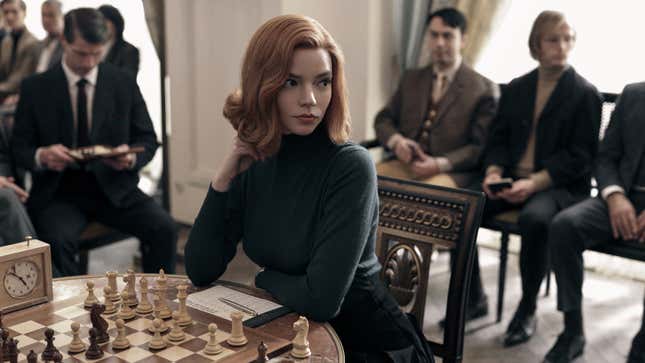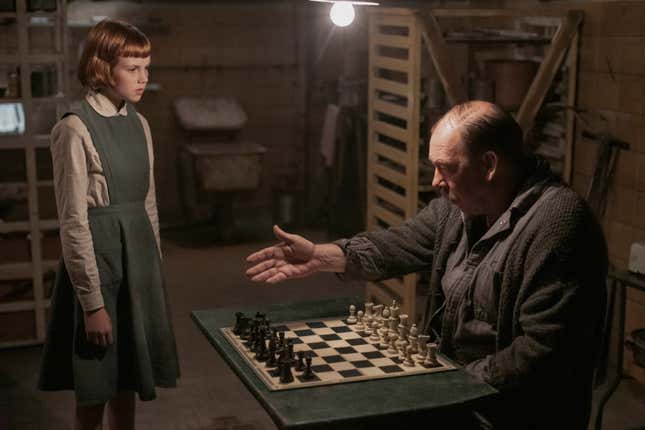
The grueling world of competitive chess isn’t the most obvious setting for an escapist tale, but The Queen’s Gambit is a frequently transportive series, filled with lavish set pieces, gorgeous costuming, and all the 1960s pop needle drops Netflix money can buy. Its more straightforward pleasures are offset by producer/writer/director Scott Frank’s meditative—and just as meticulously detailed—approach to period drama. Bridging those two worlds is a masterful performance by Anya Taylor-Joy, who leads the cast as Beth Harmon, a chess prodigy driven as much by her innate talent as her trauma.
Walter Tevis’ 1983 novel of the same name serves as the source material for the series, but The Queen’s Gambit seems to take as much inspiration from sports underdog stories and tortured-genius biopics. As such, the series is as easy to follow as it is engrossing, offering only the gentlest of curves in its narrative. Our introduction to adult Beth is a classic one: She’s running late for a fateful match with Vasily Borgov (Marcin Dorocinski). As Beth takes her seat across from the Russian grandmaster, she’s confronted by the memory of her 9-year-old self (played by Isla Johnston), standing defiantly on a bridge. It’s an early indication that Beth will have to grapple as much with herself as her competitors, a standard opening move for this type of bildungsroman.
The Queen’s Gambit then travels back to the 1950s, to the Kentucky orphanage that takes in a young Beth after her mother’s death by suicide. The staff provides only the most practical of care, using drugs to placate the children and teens, much to Beth’s future detriment. It’s here that Beth first finds refuge in the game of chess, thanks to Mr. Shaibel (Bill Camp, in an understated yet pivotal role), the orphanage’s janitor. Johnston’s portrayal is more closed-off than Taylor-Joy’s, as her Beth is one who is still in shock from losing her home and parent, but it offers flashes of the older iteration’s probing mind and ingenuity. Frustrated at the prospect of losing to Mr. Shaibel, Beth calls her chess mentor a “cocksucker.” She has no idea what the word means—that is, until she asks her friend and fellow resident Jolene (Moses Ingram)—but she correctly assumes it will offend Mr. Shaibel, possibly throwing him off his game. The moment is humorous, but it also hints at the “play to win” strategy that both propels and plagues Beth as she moves through the ranks of unranked to international grandmaster.
Frank, who wrote and directed the majority of the episodes, takes us through Beth’s adolescence with great insight and sensitivity, from the orphanage to the home of her adoptive mother Alma (Marielle Heller, stepping in front of the camera). Taylor-Joy and Heller play off each other well in the stretch that sees mother and daughter navigate the world together, cognizant of the limitations imposed on them by societal norms while frequently straining against them. The era’s prescribed gender roles are among the many period-specific details the series nails, along with spot-on, swoon-worthy ensembles—there is a velvet look to die for in the finale—from costume designer Gabriele Binder (In The Land Of Blood And Honey) and production designer Uli Hanisch’s (Babylon Berlin, Sense8) riffs on stifling mid-century parlor rooms and more psychedelic rumpus rooms.

The series also succeeds in making the cerebral game of chess come alive even for viewers who don’t know a rook from a pawn. Editor Michelle Tesoro ensures each match plays off with great flair and tension, even when the bulk of the action involves Beth staring intently across the board at her sweaty opponent. The original score from Carlos Rafael Rivera, who won an Emmy for his previous collaboration with Scott Frank, Godless, echoes Beth’s inner turmoil—the higher she climbs in the rankings, the higher she needs to get—and punctuates the turns the gameplay takes. Truly, this is as expertly made a period drama as can be.
But as studious as The Queen’s Gambit is about recreating mid-century homes and high-stakes competition, the series stumbles when it goes beyond aesthetics to establish its late ’50s/early ’60s setting. Beth is constantly faced with what her life could have been, were she not exceptionally gifted. This sobering knowledge of what it was like to be a woman, even a middle-class white woman, 40 or 50 years ago. When Beth first comes to live with Alma (and Alma’s soon-to-be-estranged husband), their living room is a veritable ocean of blues, from the valance to the throw pillows. The design choice (along with a healthy helping of anti-anxiety meds) is intended to soothe Alma’s supposedly frayed nerves, but it actually reflects the medical profession’s history of infantilizing (and in turn, harming) women. Frank’s observations are once again spot-on, but when he tries to acknowledge shifting social mores, his perception falters, along with the show’s attempts to be inclusive. The storyline regarding a queer character is more “exclusively gay moment” than character development. Jolene, the only named Black character, represents the Southern freedom fighters who are responsible for much of the social progress in this country—but only in her styling. Other than that, she exists solely to help Beth.

That can actually be said for most of the characters, including Benny Watts (Thomas Brodie-Sangster, in what looks like cosplay for his Godless role) and Harry Beltik (Harry Melling), who are virtuosos in their own right. After being handily defeated by Beth, they join her band of merry chess players, rooting for her from the sidelines (and, once she’s in Russia, from New York). Their support is lovely, even heartening, and stands in contrast to the indifferent or incapacitated figures from Beth’s early years (let alone the entire canon of stories about successful women). But it also underscores an unwillingness on the part of the show to explores Beth’s lows as well as her highs. Her substance abuse issues are established early on, but her moments of binge-drinking and pill-popping excess are too archly depicted to ever approach rock bottom. Beth’s success is never truly threatened.
Narrative bumper rails aside, The Queen’s Gambit is still an immersive experience. Taylor-Joy carries the drama of the competition and Beth’s coming-of-age story, giving off an unbridled confidence born of youth and the knowledge that she’s the best at what she does. When the story does see fit to send her plummeting (albeit briefly), Taylor-Joy handles disillusionment and grief with as much grace as Beth’s more shining moments. She’s just as good in prickly genius mode, getting inside the heads of older players and young hotshots alike. In this sense, The Queen’s Gambit is like a more introspective The Marvelous Mrs. Maisel: Both series are sumptuous period dramas that track a woman’s rise in a male-dominated field. But The Queen’s Gambit is actually aware that its protagonist can occasionally be a jerk. For all the assured direction and exotic locales—including a jaunt to Paris—Beth’s internal journey is the most captivating element of The Queen’s Gambit. The series may border on wish fulfillment at times, but at least it casts a spell.